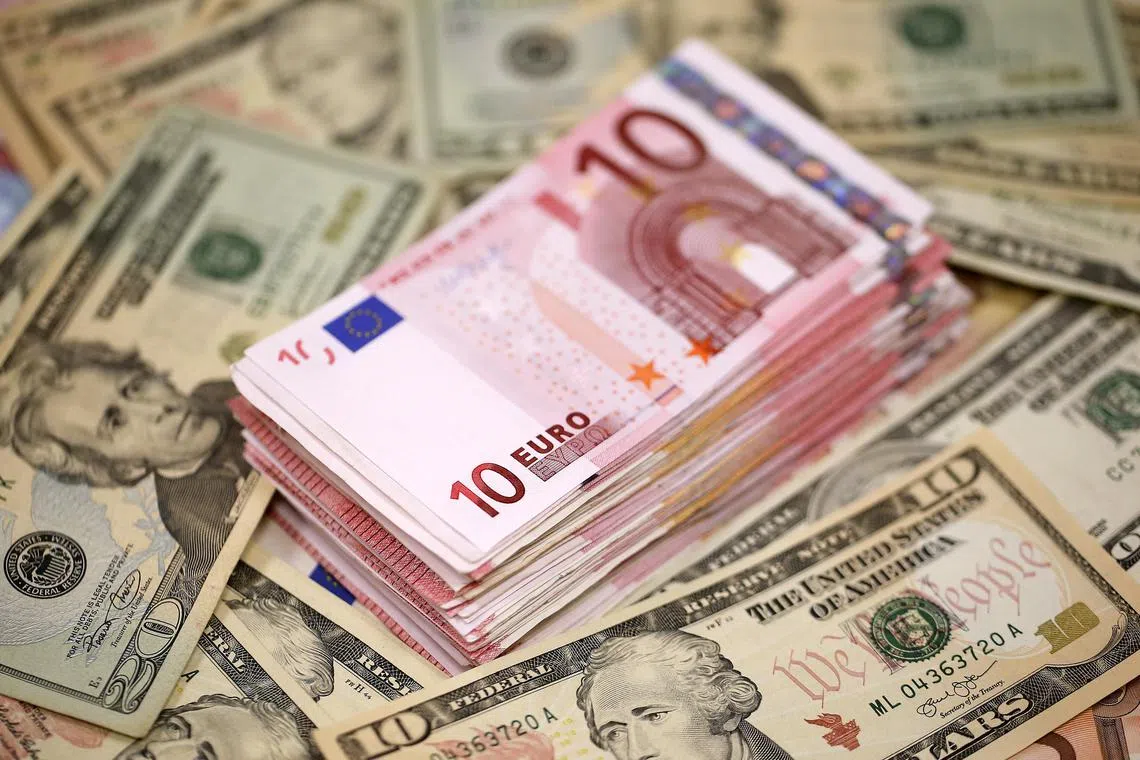Euro slips to one-month low as Macron calls French election
Sign up now: Get ST's newsletters delivered to your inbox

The euro fell to US$1.0764, its lowest since May 9, in early trading in Asia.
PHOTO: BLOOMBERG
Follow topic:
SINGAPORE – The euro fell sharply on June 10, hit by political uncertainty after gains by the far-right in voting for the European Parliament on June 9 prompted a bruised French President Emmanuel Macron to call a snap national election.
The uncertainty in France adds one more element to what will be a busy week for markets with crucial US inflation data due on June 12, the same day as a Federal Reserve policy meeting, and the Bank of Japan rounding off the week.
The euro hit a one-month low against the dollar of US$1.0748. It was last 0.35 per cent weaker at US$1.0764.
The common currency’s decline was across the board.
It dropped 0.33 per cent on the pound sterling, touching a new near two-year low of 84.51 pence, and was last down 0.22 per cent on the Swiss franc, hitting a seven-week low of 0.9639 francs.
“The election results over the weekend from the EU largely showed a pickup in support for the right-wing parties, generally what was expected, but the surprise element is that Macron has reacted by calling a snap election, so that makes the market more nervous,” said MUFG senior currency analyst Lee Hardman.
“That’s reinforced the sell-off in the euro that we saw at the end of last week, and the other factor on top of that is the US payrolls report was very strong, which increases the risk of a hawkish Fed policy signal when they meet on (June 12).”
The Federal Reserve will conclude its two-day policy meeting on June 12. Data on June 7 showed non-farm payrolls increased by 272,000 jobs in May, well above expectations of 185,000 in a Reuters poll.
Markets are now pricing in 36 basis points (bps) of Fed cuts in 2024 compared with nearly 50 bps – or at least two cuts – before the jobs data.
US consumer inflation data will be another factor in the Fed’s decision-making. While no policy shift is expected at the meeting, the Fed will issue the latest batch of “dot plots” policymakers’ projections of the path of interest rates.
At the last such release in March, the median projection was for three 25 bps rate cuts in 2024. Investors will be watching to see by how much that is revised down.
The paring back of expectations for rate cuts has been supporting the dollar for much of 2024, with the Japanese yen suffering particularly.
The dollar was last up 0.15 per cent on the Japanese currency at 157 yen, having jumped 0.7 per cent on June 7 after the payrolls print.
With the sterling steady at US$1.2722, the dollar index – which tracks the unit against six main peers – was up 0.08 per cent at 105.15.
It touched a one-month top of 105.3 in early trading.
Japan will also be in focus, as the Bank of Japan (BOJ) is due to hold its two-day monetary policy meeting on June 13 and 14, with the central bank widely expected to maintain short-term interest rates in a 0 per cent to 0.1 per cent range.
Speculation is building in the market that the BOJ may tweak its bond buying arrangements, and if the central bank fails to meet these bets, the yen could come under further pressure.
“Without any hawkish surprise, (the yen) may be sold initially following the policy announcement, similar to what we have seen after the past meetings,” analysts at Nomura said in a note.
“Moreover, in the case of dovish surprises, for example, if the BOJ avoids decreasing its Japanese government bond (JGB) purchases or decreases its JGB purchases only very slightly, there is a risk that (US dollar/yen) could overshoot to possible intervention territory again, like we saw in April.”
Japanese officials spent around 9.8 trillion yen (S$84.49 billion) on currency intervention to support the currency in April and May. REUTERS

